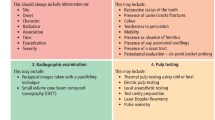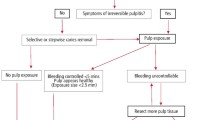Abstract
To reach an accurate endodontic diagnosis, it is important for clinicians to understand how to undertake pulpal sensibility tests correctly, how to interpret their results and how to understand their limitations. Part one of this series defined different terms relevant to pulp testing and detailed the diagnostic uses and diagnostic accuracy of pulp testing methods. This section describes clinical techniques for commonly used pulp tests and highlights their limitations and correct interpretation of their results. Applying these principles and techniques will enable accurate endodontic diagnosis in different clinical scenarios.
Key points
-
Enables a clinician to understand the mechanism of action of cold, electric and heat pulp testing.
-
Provides a summary of the correct clinical technique for undertaking cold, electric and heat pulp testing.
-
Provides the clinician with an understanding of scenarios which may give rise to false pulp testing results and an explanation of why these may occur.
This is a preview of subscription content, access via your institution
Access options
Subscribe to this journal
Receive 24 print issues and online access
$259.00 per year
only $10.79 per issue
Buy this article
- Purchase on Springer Link
- Instant access to full article PDF
Prices may be subject to local taxes which are calculated during checkout




Similar content being viewed by others
References
Mainkar A, Kim S G. Diagnostic accuracy of 5 dental pulp tests: A Systematic Review and Meta-analysis. J Endod 2018; 44: 694-702.
Ehrmann E. Pulp testers and pulp testing with particular reference to the use of dry ice. Aust Dent J 1977; 22: 272-279.
Gopikrishna V, Pradeep G, Venkateshbabu N. Assessment of pulp vitality: a review. Int J Paediatr Dent 2009; 19: 3-15.
Chen E, Abbott P V. Dental pulp testing: a review. Int J Dent 2009; DOI: 10.1155/2009/365785.
Brännström M, Johnson G. Movements of the dentine and pulp liquids on application of thermal stimuli an in vitro study. Acta Odontol Scand 1970; 28: 59-70.
Brännström M. A hydrodynamic mechanism in the transmission of pain-producing stimuli through the dentine. In Anderson D (ed) Sensory Mechanisms in Dentine. pp 73-79. Oxford: Pergamon Press,1963.
Trowbridge H O, Franks M, Korostoff E, Emling R. Sensory response to thermal stimulation in human teeth. J Endod 1980; 6: 405-412.
Hargreaves K M, Berman L H. Cohen's pathways of the pulp. 12th ed. Missouri: Elsevier, 2020.
Orstavik D. Essential Endodontology: Prevention and Treatment of Apical Periodontitis. New Jersey: John Wiley & Sons, 2020.
Fuss Z, Trowbridge H, Bender I, Rickoff B, Sorin S. Assessment of reliability of electrical and thermal pulp testing agents. J Endod 1986; 12: 301-305.
Pitt Ford T R, Patel S. Technical equipment for assessment of dental pulp status. Endod Topics 2004; 7: 2-13.
Jones D M. Effect of the type carrier used on the results of dichlorodifluoromethane application to teeth. J Endod 1999; 25: 692-694.
Ingram T A, Peters D D. Evaluation of the effects of carbon dioxide used as a pulpal test. Part 2. In vivo effect on canine enamel and pulpal tissues. J Endod 1983; 9: 296-303.
Pantera Jr E A, Anderson R W, Pantera C T. Reliability of electric pulp testing after pulpal testing with dichlorodifluoromethane. J Endod 1993; 19: 312-314.
Millard H D. Electric pulp testers. Council on Dental Materials and Devices. J Am Dent Assoc 1973; 86: 872-873.
Cooley R L, Robison S F. Variables associated with electric pulp testing. Oral Surg Oral Med Oral Pathol 1980; 50: 66-73.
Dummer P M, Tanner M, McCarthy J P. A laboratory study of four electric pulp testers. Int Endod J 1986; 19: 161-171.
Jacobson J J. Probe placement during electric pulp-testing procedures. Oral Surg Oral Med Oral Pathol 1984; 58: 242-247.
Närhi M V. The characteristics of intradental sensory units and their responses to stimulation. J Dent Res 1985; 64: 564-571.
Rubach W C, Mitchell D F. Periodontal disease, age, and pulp status. Oral Surg Oral Med Oral Pathol 1965; 19: 482-493.
Jafarzadeh H, Abbott P V. Review of pulp sensibility tests. Part I: general information and thermal tests. Int Endod J 2010; 43: 738-762.
Grossman L I. Endodontic practice. Philadelphia: Lea & Febiger, 1978.
Rowe A H, Pitt Ford T P. The assessment of pulpal vitality. Int Endod J 1990; 23: 77-83.
Lundy T, Stanley H R. Correlation of pulpal histopathology and clinical symptoms in human teeth subjected to experimental irritation. Oral Surg Oral Med Oral Pathol 1969; 27: 187-201.
Mumford J. Evaluation of gutta percha and ethyl chloride in pulp testing. Br Dent J 1964; 116: 338-342.
Zach L. Pulp lability and repair; effect of restorative procedures. Oral Surg Oral Med Oral Pathol 1972; 33: 111-121.
Rickoff B, Trowbridge H, Baker J, Fuss Z, Bender I B. Effects of thermal vitality tests on human dental pulp. J Endod 1988; 14: 482-485.
Pitt Ford H E, Pitt Ford T P, Rhodes J S. Endodontics: problem-solving in clinical practice. London: CRC Press, 2002.
Tomson R M E, Polycarpou N, Tomson P L. Contemporary obturation of the root canal system. Br Dent J 2014; 216: 315-322.
Gulabivala K, Ng YL. Endodontics. Missouri: Elsevier, 2014.
Peters D D, Baumgartner J C, Lorton L. Adult pulpal diagnosis. I. Evaluation of the positive and negative responses to cold and electrical pulp tests. J Endod 1994; 20: 506-511.
Dummer P M, Hicks R, Huws D. Clinical signs and symptoms in pulp disease. Int Endod J 1980; 13: 27-35.
Bender I B, Landau M A, Fonsecca S, Trowbridge H O. The optimum placement-site of the electrode in electric pulp testing of the 12 anterior teeth. J Am Dent Assoc 1989; 118: 305-310.
Johnsen D. Innervation of teeth: qualitative, quantitative, and developmental assessment. J Dent Res 1985; 64: 555-563.
Fearnhead R. The histological demonstration of nerve fibres in human dentine. In Anderson D (ed) Sensory Mechanisms in Dentine. pp 15-26. Oxford: Pergamon Press,1963.
Fulling H, Andreasen J. Influence of maturation status and tooth type of permanei teeth upon electrometric and thermal pulp testing. Scand J Dent Des 1976; 84: 286-290.
Andreasen J O, Andreasen F M, Andersson L. Textbook and colour atlas of traumatic injuries to the teeth. New Jersey: John Wiley & Sons, 2018.
Özçel B, Kuraner T, Kend B, Aşan E. Histopathological evaluation of the dental pulps in crown-fractured teeth. J Endod 2000; 26: 271-273.
DiAngelis A J, Andreasen J O, Ebeleseder K A et al. International Association of Dental Traumatology guidelines for the management of traumatic dental injuries: 1. Fractures and luxations of permanent teeth. Dent Traumatol 2012; 28: 2-12.
Chambers I G. The role and methods of pulp testing in oral diagnosis: a review. Int Endod J 1982; 15: 1-15.
Cave S G, Freer T J, Podlich H M. Pulp-test responses in orthodontic patients. Aust Orthod J 2002; 18: 27-34.
McDonald F, Pitt Ford T R. Blood flow changes in permanent maxillary canines during retraction. Eur J Orthod 1994; 16: 1-9.
Degering C I. Physiologic evaluation of dental-pulp testing methods. J Dent Res 1962; 41: 695-700.
Author information
Authors and Affiliations
Contributions
The original concept for the paper was devised by Kasim Butt and developed, jointly, in discussion between the two authors. Both authors wrote substantial parts of the paper, with Ian Harris revising successive drafts. Both authors contributed equally to the final approval of the version to be published.
Corresponding author
Ethics declarations
The authors declare no conflicts of interest.
Rights and permissions
About this article
Cite this article
Butt, K., Harris, I. Making sense of sensibility: part 2. Br Dent J 232, 379–384 (2022). https://doi.org/10.1038/s41415-022-4039-7
Received:
Accepted:
Published:
Issue Date:
DOI: https://doi.org/10.1038/s41415-022-4039-7



